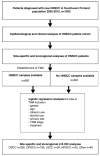Epidemiological Study of p16 Incidence in Head and Neck Squamous Cell Carcinoma 2005-2015 in a Representative Northern European Population
- PMID: 36428809
- PMCID: PMC9688375
- DOI: 10.3390/cancers14225717
Epidemiological Study of p16 Incidence in Head and Neck Squamous Cell Carcinoma 2005-2015 in a Representative Northern European Population
Abstract
The incidence of human papillomavirus (HPV)-associated head and neck squamous cell carcinomas (HNSCC) has increased globally. Our research goal was to study HNSCC incidence in a representative Northern European population and evaluate the utility of the HPV surrogate marker p16 in clinical decision-making. All new HNSCC patients diagnosed and treated in Southwest Finland from 2005-2015 (n = 1033) were identified and analyzed. During the follow-up period, the incidence of oropharyngeal (OPSCC) and oral cavity squamous cell carcinoma (OSCC) increased, while the incidence of laryngeal squamous cell carcinoma (LSCC) decreased. This clinical cohort was used to generate a population-validated tissue microarray (PV-TMA) archive for p16 analyses. The incidence of p16 positivity in HNSCC and OPSCC increased in southwest Finland between 2005 and 2015. p16 positivity was mainly found in the oropharynx and was a significant factor for improved survival. p16-positive OPSCC patients had a better prognosis, regardless of treatment modality. All HNSCC patients benefited from a combination of chemotherapy and radiotherapy, regardless of p16 expression. Our study reaffirms that p16 expression offers a prognostic biomarker in OPSCC and could potentially be used in cancer treatment stratification. Focusing on p16 testing for only OPSCC might be the most cost-effective approach in clinical practice.
Keywords: HNSCC; HPV; OPSCC; epidemiology; incidence; p16; survival.
Conflict of interest statement
The authors declare no conflict of interest. The funders had no role in the design of the study; in the collection, analyses, or interpretation of data; in the writing of the manuscript, or in the decision to publish the results.
Figures








Similar articles
-
A comprehensive evaluation of human papillomavirus positive status and p16INK4a overexpression as a prognostic biomarker in head and neck squamous cell carcinoma.Int J Oncol. 2014 Jul;45(1):67-76. doi: 10.3892/ijo.2014.2440. Epub 2014 May 12. Int J Oncol. 2014. PMID: 24820457 Free PMC article.
-
Is the improved prognosis of p16 positive oropharyngeal squamous cell carcinoma dependent of the treatment modality?Int J Cancer. 2010 Mar 1;126(5):1256-62. doi: 10.1002/ijc.24842. Int J Cancer. 2010. PMID: 19697324
-
Low prevalence of p16-positive HPV-related head-neck cancers in Thailand: tertiary referral center experience.BMC Cancer. 2019 Nov 6;19(1):1050. doi: 10.1186/s12885-019-6266-0. BMC Cancer. 2019. PMID: 31694600 Free PMC article.
-
Human papillomavirus and oral and oropharyngeal carcinoma: the essentials.Aust Dent J. 2019 Mar;64(1):11-18. doi: 10.1111/adj.12652. Epub 2018 Oct 7. Aust Dent J. 2019. PMID: 30238467 Review.
-
The role of high-risk human papillomavirus infections in laryngeal squamous cell carcinoma.Eur Arch Otorhinolaryngol. 2017 Nov;274(11):3837-3842. doi: 10.1007/s00405-017-4718-1. Epub 2017 Aug 31. Eur Arch Otorhinolaryngol. 2017. PMID: 28861601 Review.
Cited by
-
Predicting specific mortality from laryngeal cancer based on competing risk model: a retrospective analysis based on the SEER database.Ann Transl Med. 2023 Feb 28;11(4):179. doi: 10.21037/atm-23-400. Ann Transl Med. 2023. PMID: 36923079 Free PMC article.
-
LIMA1-alpha staining predicts curative intent surgery response in HPV negative head and neck cancer.EMBO Mol Med. 2025 Aug;17(8):2095-2114. doi: 10.1038/s44321-025-00266-8. Epub 2025 Jul 17. EMBO Mol Med. 2025. PMID: 40676267 Free PMC article.
-
xCT as a Predictor for Survival in a Population-Based Cohort of Head and Neck Squamous Cell Carcinoma.Cancer Med. 2024 Nov;13(21):e70371. doi: 10.1002/cam4.70371. Cancer Med. 2024. PMID: 39487701 Free PMC article.
-
The Expressions of p16, HPV16-L1 and HPV18-E6 in Salivary Gland Tumours.Indian J Otolaryngol Head Neck Surg. 2024 Dec;76(6):5470-5477. doi: 10.1007/s12070-024-05007-w. Epub 2024 Sep 11. Indian J Otolaryngol Head Neck Surg. 2024. PMID: 39559137
-
Study on pathological factors affecting the sensitivity of neoadjuvant therapy in hypopharyngeal cancer.Cancer Immunol Immunother. 2025 Feb 25;74(4):118. doi: 10.1007/s00262-025-03957-w. Cancer Immunol Immunother. 2025. PMID: 39998637 Free PMC article.
References
-
- Gillison M.L., Koch W.M., Capone R.B., Spafford M., Westra W.H., Wu L., Zahurak M.L., Daniel R.W., Viglione M., Symer D.E., et al. Evidence for a Causal Association Between Human Papillomavirus and a Subset of Head and Neck Cancers. J. Natl. Cancer Inst. 2000;92:709–720. doi: 10.1093/jnci/92.9.709. - DOI - PubMed
-
- Chaturvedi A.K., Engels E.A., Pfeiffer R.M., Hernandez B.Y., Xiao W., Kim E., Jiang B., Goodman M.T., Sibug-Saber M., Cozen W., et al. Human Papillomavirus and Rising Oropharyngeal Cancer Incidence in the United States. J. Clin. Oncol. 2011;29:4294–4301. doi: 10.1200/JCO.2011.36.4596. - DOI - PMC - PubMed
-
- Mehanna H., Beech T., Nicholson T., El-Hariry I., McConkey C., Paleri V., Roberts S. Prevalence of human papillomavirus in oropharyngeal and nonoropharyngeal head and neck cancer-systematic review and meta-analysis of trends by time and region. Head Neck. 2013;35:747–755. doi: 10.1002/hed.22015. - DOI - PubMed
Grants and funding
LinkOut - more resources
Full Text Sources

